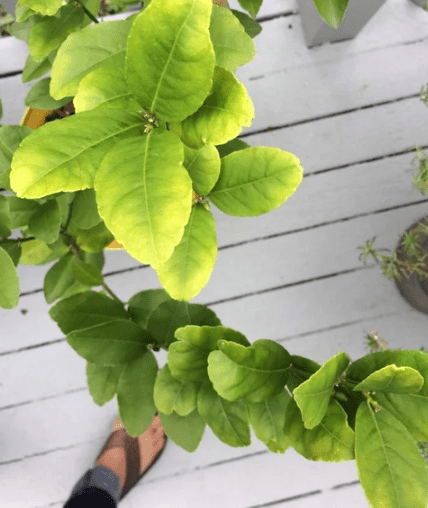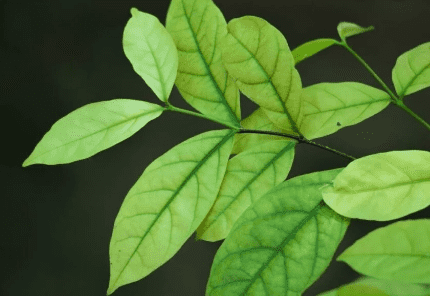
Have you ever noticed unusually pale or yellow plant leaves? Fortunately, the abnormal growing circumstances that result in pale leaves can be corrected.
Overwatering, food deficiency, and insufficient sunlight can all result in pale plant leaves by lowering the quantity of chlorophyll, which is what gives green leaves their color. Additionally, phyllody and chloranthy, two hereditary diseases in plants, might be indicated by pale plant leaves.
When petals instead of flower components form, the condition is known as phyllody.
I will go into additional detail about this in this essay, along with numerous other contributing elements and corrective measures.
Table of Contents
What Causes Pale Plant Leaves?

Pale leaves can be caused by a variety of environmental variables. Below we discuss a few of them:
Too Much Sunlight:
For plants to function effectively, they need sufficient sunlight. But too much of something might actually be harmful.
Long-term exposure to direct sunshine causes plants to transpire too much water, which can cause dehydration.
The plant may become stressed with too much sunshine and be unable to adequately carry out photosynthesis.
Dehydration and stressful situations harm plants, which manifests as faded, bleached, or pale leaves.
There may be dark burn-like markings on the leaves in addition to the pale foliage. These are symptoms of sunburn, and they require adequate attention.
Lack of Sunlight:
One of the most common causes of pale leaves in plants is lack of sun exposure. Chlorophyll, as we are all aware, is a pigment found in plants that is essential to photosynthesis.
When chlorophyll is active, leaves are the hue green they are.
Chlorophyll may not be able to fully fulfill its purpose when a plant does not receive enough sunlight. The result is the drab plant leaves.
Overwatering:
Like sunlight, excessive watering can be detrimental to plant health. Overwatering or excessively watering plants reduces the oxygen supply, which causes the roots to decay and prevent any water from penetrating.
Additionally, water does not get to the plant’s leaves and other sections. Yellowing of the leaves and slowed growth are the results.
Insufficient Watering:
Lack of water prevents all necessary nutrients from reaching a plant’s leaves. Due to dehydration and starvation, this may slow growth.
It may begin to rain flowers and leaves everywhere. Flowers might not even begin to sprout. The leaves will probably become fragile and light yellow. Continued dehydration will cause the plant to dry up and ultimately die.
Lack of Nutrients:
For optimum growth, plants require more than a dozen vital nutrients. The plant may not receive sufficient nutrition if the soil lacks nutrients or if the roots are injured.
This may result in nutritional deficiencies, which manifest as leaves with paler tissues and greener veins. The following is a list of several typical nutrient deficits that can result in pale leaves:
Nitrogen Deficiency:
Older leaves can become completely pale due to a nitrogen deficit. They seem diminutive and could fall. Stunted growth might also result from a lack of nitrogen. The younger leaves will likewise become pale as this situation worsens.
Magnesium Deficiency:
Magnesium is crucial for the health of plants. Older and inner leaves may yellow if it is lacking. They could come off as frail and skinny. The leaves do not always become completely yellow due to magnesium shortage. While the midrib is still green, there are yellow dots and patches visible between the leaf veins.
Iron Deficiency:
Younger leaves will become pale if a plant is iron deficient. Dark green leaves will have light yellow tint between the veins. Stunted growth might also result from an iron shortage.
Potassium Deficiency:
A potassium deficiency is shown by leaf edges that are pale while the inside leaf is still green. It’s possible for leaf margins to turn brown. The crinkling of leaves, diminished blossoming, and early death of young shoots are other indications of potassium deficiency.
Zinc Deficiency:
A zinc shortage may manifest as distorted leaves and pale spots between leaf veins.
Sulfur Deficiency:
Similar signs of a sulfur deficiency might be seen in a nitrogen deficiency. The only exception is that younger leaves will yellow or develop chlorosis when there is a sulfur shortage. Older leaves could have lighter green and smaller appearances. Another sign of sulfur insufficiency is stunted shoot growth.
My plants’ leaves, stems, and general health have been strengthened thanks to the cost-effective liquid fertilizer Purived. Clicking here will take you there!
Pests:
Pests may be to blame if any of the aforementioned factors are not the reason for pale plant leaves. Small holes or leaf portions missing from leaves are another indication of bugs.
The most prevalent pests are aphids, which primarily attack young trees and small plants. They develop slowly because they suck the plant’s nutritious sap. The plant’s leaves become pale and curl up.
Spider mites are another pest that may result in pale foliage. Spider mites are responsible for the mottled browning of leaves, which is similar to a virus.
Can Pale Leaves Turn Green Again?

NO, is the answer. Your pale leaves cannot be made green once more. Most of the time, leaf yellowing is persistent and irreparable. These pale leaves may need to be removed, then you must wait for new leaves to emerge.
If the yellowing is young and mild, the harm can be repairable.
There are very few, but not zero, odds of a detrimental reversal if pale leaves are the result of nutrient shortage. To ensure that new leaves don’t display the same symptoms, try providing nutrients to make up for the nutritional shortfall.
But there is nothing that can be done to stop yellowing brought on by carelessness; the only option is to start over. Therefore, if the leaves on your plant are becoming pale, you need to identify the root of the issue as soon as possible.
Do Pale Leaves Absorb Less Sunlight?
Yes, compared to green leaves, pale leaves do absorb less sunlight. Plants contain the photosynthetic pigment chlorophyll. It is in charge of giving leaves their green hue. Additionally, it absorbs the majority of the sunlight needed for photosynthesis.
Fewer chlorophyll molecules are present in pale leaves. Carotenoids, another type of pigment, are still present in pale leaves.
Although less effectively than chlorophyll, some pigments can nevertheless absorb sunlight. As a result, light is not as effectively absorbed by pale leaves.
How to Make Pale Plant Leaves Greener?
The majority of gardeners panic at the first hint of leaf yellowing and are clueless on what to do. Here are a few things you can do to stop additional harm and turn pale plant leaves greener:

Improve Watering Methods:
Overwatering can result in pale plant leaves and harm plant roots owing to overflow. Start by using high-quality soil and maintaining it in a pot with a functional drainage system to stop this.
If you want to grow plants in your garden, pick a location where rainwater won’t collect.
Do a water test on the soil prior to watering your plants. Slide your finger into the ground. Give it enough water if it seems dry. For a few days, cease watering if it seems moist and soft. Only use water when it seems dry.
Use Fertilizer:
Your plant may have nutritional deficiencies if your soil lacks a sufficient amount of nitrogen.
Due to a lack of chlorophyll, this might result in pale plant leaves, which can be corrected by adding nitrogen.
It is essential to have your soil analyzed if you think there may be a nutrient shortage.
After that, you can use fertilizer to make up the shortage. To make up for the nitrogen shortfall, a fertilizer high in nitrogen can be utilized.
A greater “N” value in the N:P:K ratio indicates that the fertilizer is nitrogen-rich, making it easy to identify. the time is 20:10:10.
As nitrogen can be readily absorbed by the leaf through its stomata, foliar feeding is the most efficient method of supplying nitrogen to the plant. See our thorough post on feeding the leaves.
I have found that Miracle-Gro Soluble fertilizer produces the finest results. It offers excellent value for the money and is durable. Clicking here will take you there.
Provide adequate lighting:
Too much or too little sunlight is another factor in pale plant leaves. The leaves might become bleached from too much sun. The growth of plants is hampered by insufficient sunshine, which also causes the yellowing of leaves.
Some plants need more sunshine to survive, while others need less. Find out how much sunshine your plant actually requires before placing it in the sun. The goal is to give the plant adequate sunshine so that it can operate normally.
Use Pesticide:
Your plant’s health might be negatively impacted by insects and pests. Pests can rob your plant of its sap and limit its growth. Plant leaves may become pallid as a result. Use a pesticide on your plants to get rid of any bugs and stop further infestations.
Neem oil, peppermint oil, or any other homemade pesticides are options if you don’t want to use chemical pesticides. These all-natural options are inexpensive and risk-free.
Can Artificial Light Cause Pale Plant Leaves?
The best source of light for plants to grow is exposure to the sun. Since artificial light does not offer the whole spectrum of natural light required for holistic growth, it cannot be compared to sunlight. Pale plant leaves can be a result of both inadequate sunshine and improper artificial light use.
It’s important to give balanced illumination, and we’ve located a reliable artificial grow light on Amazon that does the job by offering the proper spectrum of light. Clicking here will take you there.
But not all artificial lighting is terrible. Artificial light can take the place of sunlight if the right wavelength is utilized. This is especially advantageous for indoor plants and plants with restricted access to sunshine.
Artificial light can fuel growth and assist in photosynthesis. Additionally, it can promote germination and avoid early plant mortality. LEDs, glow lights, incandescent lamps, and fluorescent lamps are a few types of artificial lighting that are frequently utilized for plant development.
The Takeaway
Pale plant leaves may be a sign that there is a problem with your plant. There are numerous environmental and genetic factors that can contribute to it. These environmental factors include excessive or insufficient sunlight, over- or underwatering, pests, or a lack of nourishment.
Your pale plant’s leaves can turn greener and stop yellowing with enough sunlight, good watering, pest control, and fertilizer application.
